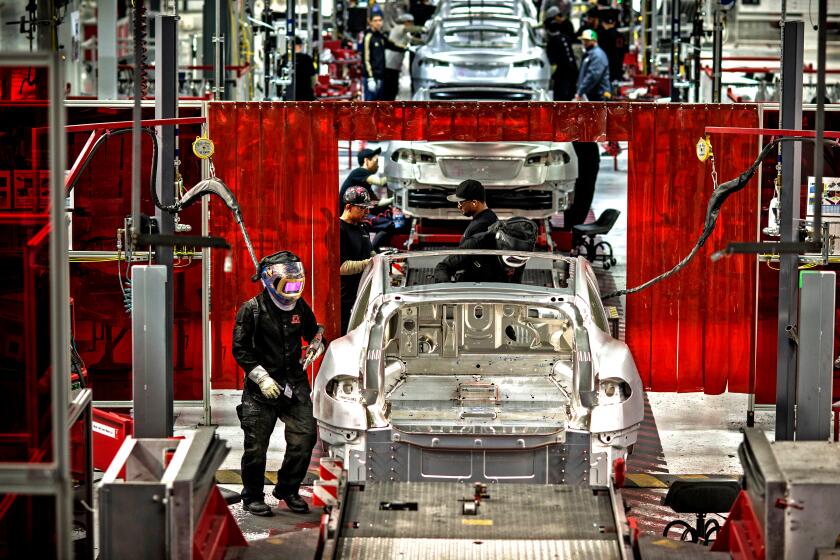Big Three Pressed U.S. to Lighten Up on Dollar Policy
Just four years ago, Japanese auto makers were struggling to make ends meet in the United States. The weakening of the dollar forced their vehicle prices up, giving the Big Three a $3,000 price advantage per car.
So Toyota, Honda and Nissan began instituting changes aimed at making profits even if the dollar fell another 15% to a level of 85 yen. Their already-world-class development and production costs were lowered more.
Now the worm has turned. The yen is weak and the dollar strong.
And the lean-and-mean Japanese auto makers, using greater production efficiencies and the favorable currency trends, are holding the line on their U.S. vehicle prices--enabling them to once again grab new chunks of U.S. market share after several years of treading water.
The Big Three have raised prices an average of $470 per vehicle since the beginning of the 1997 model year in October, according to an analysis by Automotive News, while the Japanese raised prices just $8 a vehicle on average.
Indeed, rather than match the Japanese on pricing strategy, Detroit’s response has been to ask the government for help.
In recent weeks, Chrysler, Ford and General Motors stepped up lobbying of the Clinton administration, particularly Treasury Secretary Robert Rubin, to reverse the strong-dollar policy.
And last week, the government acted. With the dollar recently pushing past the 120-yen mark--50% higher than in mid-1995--Rubin signaled that the trend had gone far enough. This week the administration sought the help of the world’s top industrial nations to act in concert and push the dollar down from its 124-yen peak.
So far the results are mixed. After slipping on Monday, the dollar surged Tuesday to settle in New York at 123.15 yen, only 1.55 yen lower than the four-year high reached before Rubin’s comments Friday.
Whatever the outcome, to hear some in Detroit tell the story, there is a conspiracy between the Japanese government and its auto makers to keep the yen weak. This, they say, supports Japan’s plan to export its way out of its current economic slump.
“It’s tough enough competing against the Japanese auto companies; going against the Japanese government is darn near impossible,” said G. Richard Wagoner, president of GM’s North American operations.
But analysts say such familiar complaints are largely out of date. The Japanese are exporting far fewer products to the United States than ever as they have transferred more production offshore, not only to the United States but to neighboring Asian countries.
So dollar-yen currency swings have much less impact today than 10 to 15 years ago, when a far stronger dollar--as much as 270 yen--helped Japanese companies establish their huge presence in the U.S. market.
The Japanese admit that the weaker yen provides a big benefit on vehicles they ship here from Japan. But increasingly, the Japanese are building their most popular U.S. vehicles here. Toyota says that 61% of its U.S. sales came from cars and trucks built in North America with 75% U.S. components--vehicles that got little benefit from the weaker yen.
Moreover, analysts say the Japanese have kept prices down not only with the help of the weakening yen, but because of the increased efficiency of their manufacturing operations, both in the United States and Japan.
“This is really a false issue,” said James Olson, executive vice president of Toyota Motor Sales USA in Torrance. “The Big Three are making a lot of noise in hopes of gaining a political and competitive advantage. They want us to raise our prices.”
The currency issue is a tough one for the Big Three because a strong dollar benefits American consumers by helping to keep inflation in check and interest rates low.
But GM, Ford and Chrysler say the weak yen translates into a major competitive threat that could reverse their hard-won gains of recent years and hurt the U.S. economy.
A weak yen creates havoc in several ways for Detroit. It allows the Japanese auto makers to either hold prices steady and collect greater profits that can be poured back into new products and plants--or to use the currency windfall to lower prices and gain market share. And it makes their U.S. products more expensive overseas, threatening efforts to crack Asian markets.
“If GM, Ford and Chrysler start to lose market share, then we could see production cutbacks and job losses that could hurt the U.S. economy,” warned Andrew Card, president of the American Automobile Manufacturers Assn., the Big Three’s lobbying arm.
The U.S. auto makers began sounding the alarm in a big way when January sales figures were reported. Toyota, Honda and Nissan all recorded double-digit sales increases. Overall, the Japanese auto makers claimed 24.5% of the vehicle market, up 3.3 percentage points; the Big Three share was 71.1%, down 3.7 points.
Analysts said the combination of a weaker yen and an increase in operating efficiencies have given the Japanese greater pricing flexibility than ever before. Even though the sticker prices on Japanese vehicles continue to be higher than those for domestic cars and trucks, the Japanese have been effectively using rebates, incentives and lease subsidies to compete.



